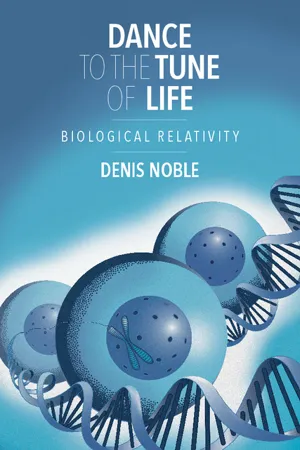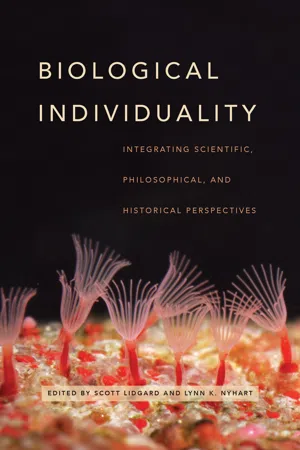Biological Sciences
Biological Structures
Biological structures refer to the various anatomical components of living organisms, such as cells, tissues, organs, and organ systems. These structures are essential for the functioning and survival of organisms, providing support, protection, and the means for carrying out vital processes like respiration, digestion, and reproduction. Understanding biological structures is fundamental to comprehending the complexities of life and the mechanisms underlying biological functions.
Written by Perlego with AI-assistance
Related key terms
1 of 5
6 Key excerpts on "Biological Structures"
- eBook - PDF
Mathematical Nature Of The Living World, The: The Power Of Integration
The Power of Integration
- Gilbert A Chauvet(Author)
- 2004(Publication Date)
- World Scientific(Publisher)
This is followed by the reconstitution of new sets of molecules by chemical techniques. Finally, these molecules are studied to determine the physical principles underlying the stability — or the instability — of matter. Thus, the significance of the physical notion of structure is reasonably clear. IV 122 From the biologist’s point of view , the concept of structure is inextricably linked with that of function. For this reason, the general definitions of epistemology, no matter how precise they may be, will have to take into account not only the bio-logical nature of the object studied but also the biological method used. Biological organization has three major char-acteristics. First, the definition of a given biological structure depends upon experimental constraints since it must be defin-able according to morphological, or at least quantitative, criteria. Thus, a ribosome observed inside a cell, the cell itself, and the tissue to which the cell belongs, all constitute distinct structures that can be observed and analyzed. The associated functions are often intuitively defined as the set of activities or transfor-mations subtended by the corresponding structures. Secondly, the anatomical and histological hierarchy does not coincide with the hierarchy of the physiological functions or sub-functions. And thirdly, the higher we rise in the anatomical or functional hierarchy, the smaller is the number of elements involved, tending to the order of unity since the organism itself is at the highest level of biological organization. To be coherent with the definition of the function, the struc-ture will be considered as the spatial, “physical” arrangement of the elements of the system . In this sense, the structure will not be identified with the relational structure of the system but will coincide with the histology and the anatomy of the system such that the structural hierarchy corresponds to the hierarchy of the material system observed. - eBook - PDF
Structuralism And Structures
A Mathematical Perspective
- Charles E Rickart(Author)
- 1995(Publication Date)
- World Scientific(Publisher)
C H A P T E R VIII B I O L O G I C A L S T R U C T U R E S 49. Introduction In biology, as in all scientific fields, notions of structure are everywhere present. Although structures are often not the direct objects of attention in science, they tend to lie relatively near the surface. T h i s is especially true in biology, where structure stands out in much of the material and is often dealt with explicitly. Structures are evident at all levels, ranging from molecular biology, where they are perhaps most explicit and merge into purely chemical and physical structures, through traditional biology to population and sociobiology, where they blend into the general structures associated with social phenomena. Central in all of this is the human brain. It is perhaps the most complex of all the structures that we ever encounter, and is capable, in a sense, of modeling all of the others. A comprehensive structural analysis of any part of biology would obvi-ously be interesting strictly from the point of view of structures, but would be a difficult task even for a biologist, and probably not of great impor-tance to biology proper. Needless to say, our immediate objective, as in other areas that we have considered, is not to attempt a serious structural analysis of any portion of the subject, but rather to try to learn more about general structures by examining some of the special ways that they enter into biology. A structural approach of this kind, though it may not be revolutionary in effect, does throw a different light on some of the topics to which it is applied. It is also obvious that it w i l l influence the choice of material to be examined. In the case of biology, the result is a prepon-derance of topics from the theory of evolution. The subject of evolution is particularly appropriate here since much of its material is fairly accessible and also directly concerned with structure. - eBook - PDF
Dance to the Tune of Life
Biological Relativity
- Denis Noble(Author)
- 2016(Publication Date)
- Cambridge University Press(Publisher)
The full reasons for her insight will become clear in Chapters 6 and 7 of this book. The word organ therefore includes the concept of purpose, what the organ is for. There are organs, in this general sense, at all levels of biological organ- isation (and notice the appearance of ‘organ’ also in that word). This should warn us that nature doesn’t need to pay too much attention to our ways of classifying her. When we come to develop the full principle of Biological Relativity, this fact will become very important. Whole-Body Systems The term ‘systems biology’ rapidly became a buzz phrase during the first decade of this century. Before the year 2000 it was rarely used, although the word ‘systems’ was used in a related sense in ‘systems physiology’, and in ‘systems engineering’, ‘systems theory’ and other related disciplines. Why did this development happen so quickly? In part, it was a reaction to a great achievement, the sequencing of the complete human genome. There were a lot of surprises arising from that work. One of them was that people realised that sequencing the genome would not be sufficient to answer the question ‘what is life?’. A new approach was needed. Having smashed Humpty-Dumpty into billions of pieces – all those molecules forming genes and proteins – the time had come to work out how to put him together again. This necessarily requires building up rather than breaking down, integration to complement reduction. This is what 56 DANCE TO THE TUNE OF LIFE systems biology is about. But the systems approach is not new. The word ‘systems’ has a long history in physiology. The various organs of the body form parts of whole-body physiological systems within which their func- tion is defined and implemented. The new generation of ‘systems biolo- gists’ has tended to ignore this use of the term ‘system’, and to focus on the biochemical networks inside cells. It is an important message of this book that this is a limitation. - eBook - ePub
Invisible Crisis of Contemporary Society
Reconstructing Sociology's Fundamental Assumptions
- Bernard S Phillips, Louis C. Johnston(Authors)
- 2015(Publication Date)
- Routledge(Publisher)
ART IIPhysical and Biological StructuresFew social scientists emphasize the importance of physical and Biological Structures in their analysis of human behavior. Yet a broad approach to the scientific method demands that those structures be included within any comprehensive analysis of human behavior. This view does not require that every research project undertaken at this time must include those structures. From the pragmatic perspective of Charles Sanders Peirce, we have the dictum—“Do not block the way of inquiry”—which is a perspective that we shall examine in chapter 6 . That dictum points us toward our continuing development of an understanding of human behavior without any limits. Whatever the limits within present investigations, they conform to Peirce’s advice insofar as they point toward improving that understanding in the future. And that improvement includes seriously addressing the role of physical and Biological Structures.Physical and Biological Structures appeared long before our social and personality structures. By taking them into account we are also going far back in history, even to the origins of the universe. The dimension of time is involved no less than broad attention to all structures. Yet, one might ask, are those structures really so important? Although attention to them might satisfy some abstract ideal for comprehensiveness and a long-term perspective, are they genuinely relevant to our understanding of human behavior, given so many other factors that should be taken into account? It is exactly such questions that we shall explore in part II .At this point, however, we can at least begin to examine the relevance of physical and Biological Structures for an analysis of human behavior. It is difficult to imagine a metaphysical stance or worldview which does not include attention to physical and Biological Structures. It is true that within the history of Western philosophy there has been a turning toward emphasizing the importance of human behavior, as illustrated by the work of the British empiricists, by Marx and Hegel, and by the newer philosophies of pragmatism and existentialism. Yet all of that attention should not take away from the importance of physical and Biological Structures. A metaphysical stance or worldview must be comprehensive if it is indeed to constitute a worldview. This is important not just for its impact on limiting or opening up our approach to the scientific method. It is also important for reasons that as yet we do not understand, given our limited knowledge of human complexity. - eBook - ePub
Biological Individuality
Integrating Scientific, Philosophical, and Historical Perspectives
- Scott Lidgard, Lynn K. Nyhart, Scott Lidgard, Lynn K. Nyhart(Authors)
- 2017(Publication Date)
- University of Chicago Press(Publisher)
2 I detail how this perspective clarifies some current debates and in several contexts permits fruitful biological investigation beyond the structure-function dichotomy. One reason is that function in my sense is compatible with but conceptually independent of natural selection. Another reason is that a body composed of functions is at the same time composed of structures, where the structures and functions can stand in hierarchical part-whole relations among each other, enabling the multilevel explanation of organismal organization and its developmental formation and evolutionary modification. I conclude with a pluralistic approach to individuation, which assumes that different individuation schemes for bodily parts are to be used in different biological contexts, relative to the epistemic aims in operation (see also Lidgard and Nyhart, this volume; Love and Brigandt, this volume; Sterner 2015).Individuating a Structure Can Take Us to Its Functional Context
Apart from traditional accounts of biological individuality that address physiological functioning and autonomy, nowadays evolutionary approaches are prominent that focus on individuals as units that are subject to selection and figure in transgenerational evolutionary change (Godfrey-Smith 2013; Love and Brigandt, this volume). Especially on the latter approach, an important characteristic of biological individuality is the ability to reproduce. A bodily part—a part of an organism—usually does not have this ability (with the exception of the cells of a multicellular individual, which retain a significant degree of individuality). Bodily parts may still be said to form cross-generational lineages, as in cases of homology the same kind of part reappears across generations (the bodily part is replicated), though the bodily part alone does not have the causal means of replicating itself.3 But despite their lack of full biological individuality, it is of central epistemic importance to individuate - eBook - PDF
- J. H. U. Brown, Donald S. Gann(Authors)
- 2014(Publication Date)
- Academic Press(Publisher)
Π. SYSTEMS PHYSIOLOGY A. Definitions The central concept of this branch of physiology is that an arrangement of biological components, coupled, connected, and interacting, has properties beyond the sum of those to be found in the components individually. There-fore, systems physiology is the science of the static, quasi-static, and dynamic properties of components. The properties of a system of connected components * Certain portions of this chapter are based on an article that appeared in Physiologist. 11,115-133 (1968). 3 1 4 F. EUGENE YATES Table I Biology Behavioral and population sciences I Synthesis of lower level mechanisms into higher level performance, including self-construction and information processing Systems Ph~SiOIOgy Physiological sciences Biophysical Analysis of mechanisms, including those of self-construction and information processing I . hI . I BlOC emlca Morphological sciences ~ depend on (a) the nature of the components individually, (b) the nature of the individual connections and coupling relations, and (c) the arrangement of components and the paths of communication among them. By definition these system properties lie outside the scope of molecular biology and represent the province of systems physiology, in which the structural integrity of components is accepted and the dissolution of structure is minimized. Systems physiology emphasizes those attributes that define a system as living (1). Systems physiology poses the questions and sets the goals for analytical biology generally. It is characterized by its point of view, by the kinds of questions it asks, and the kinds of answers it seeks, rather than by the level of organization at which a study is made. The power of the systems viewpoint lies precisely in its general applicability for many levels of organization in biology, and in its emphasis on the characterization of detailed mechanisms and their incorporation into dynamic performance at higher levels.
Index pages curate the most relevant extracts from our library of academic textbooks. They’ve been created using an in-house natural language model (NLM), each adding context and meaning to key research topics.





